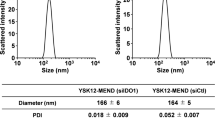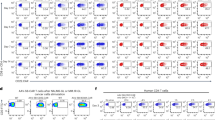Abstract
Ribonucleic acid (RNA) transfection of dendritic cells (DCs) was shown to be highly efficient in eliciting CD8+ and CD4+ T-cell responses. We analyzed whether electroporation of DCs with RNA coding for a tumor-associated antigen (TAA) would elicit antigen-specific effector cytotoxic T lymphocyte (CTL) responses and whether these responses could be modulated by cotransfection with a second specific synthetic RNA. Therefore in vitro generated human monocyte-derived DCs were electroporated with in vitro transcribed RNA (in vitro transcript, IVT) encoding the TAA HER-2/neu. Additionally, these cells were cotransfected with IVT coding for human 4-1BBL. Transfection of DCs with 4-1BBL-IVT did not alter their typical phenotype. However, it increased the expression of the costimulatory molecules CD80 and CD40. Coadministration of HER-2/neu- and 4-1BBL-IVT resulted in an increased specific lysis of target cells by the in vitro induced CTL lines, indicating that 4-1BBL enhances their ability to elicit primary CTL responses. Interestingly, transfection of DCs with 4-1BBL-IVT did not augment their capacity to stimulate allogeneic lymphocyte responses. The here established approach of cotransfection of DCs with tumor-RNA and a second specific IVT could improve and optimize the in vitro manipulation of DCs for the induction of antigen-specific CTL responses.
This is a preview of subscription content, access via your institution
Access options
Subscribe to this journal
Receive 12 print issues and online access
$259.00 per year
only $21.58 per issue
Buy this article
- Purchase on Springer Link
- Instant access to full article PDF
Prices may be subject to local taxes which are calculated during checkout




Similar content being viewed by others
References
Mellman I, Steinman RM . Dendritic cells: specialized and regulated antigen processing machines. Cell. 2001;106:255–258.
Steinman RM . The dendritic cell system and its role in immunogenicity. Annu Rev Immunol. 1991;9:271–296.
Boczkowski D, Nair SK, Snyder D, Gilboa E . Dendritic cells pulsed with RNA are potent antigen-presenting cells in vitro and in vivo. J Exp Med. 1996;184:465–472.
Grünebach F, Müller MR, Nencioni A, Brossart P . Delivery of tumor-derived RNA for the induction of cytotoxic T-lymphocytes. Gene Ther. 2003;10:367–374.
Hoerr I, Obst R, Rammensee HG, Jung G . In vivo application of RNA leads to induction of specific cytotoxic T lymphocytes and antibodies. Eur J Immunol. 2000;30:1–7.
Müller MR, Grünebach F, Nencioni A, Brossart P . Transfection of dendritic cells with RNA induces CD4- and CD8-mediated T cell immunity against breast carcinomas and reveals the immunodominance of presented T cell epitopes. J Immunol. 2003;170:5892–5896.
Nair SK, Boczkowski D, Morse M, Cumming RI, Lyerly HK, Gilboa E . Induction of primary carcinoembryonic antigen (CEA)-specific cytotoxic T lymphocytes in vitro using human dendritic cells transfected with RNA. Nat Biotechnol. 1998;16:364–369.
DeBenedette MA, Shahinian A, Mak TW, Watts TH . Costimulation of CD28- T lymphocytes by 4-1BB ligand. J Immunol. 1997;158:551–559.
Goodwin RG, Din WS, Davis-Smith T, et al. Molecular cloning of a ligand for the inducible T cell gene 4-1BB: a member of an emerging family of cytokines with homology to tumor necrosis factor. Eur J Immunol. 1993;23:2631–2641.
Salih HR, Kiener PA, Nussler V . 4-1 BB ligand--just another costimulating molecule? Int J Clin Pharmacol Ther. 2002;40:348–353.
Vinay DS, Kwon BS . Role of 4-1BB in immune responses. Semin Immunol. 1998;10:481–489.
Brossart P, Grünebach F, Stuhler G, et al. Generation of functional human dendritic cells from adherent peripheral blood monocytes by CD40 ligation in the absence of granulocyte-macrophage colony-stimulating factor. Blood. 1998;92:4238–4247.
Zhou LJ, Tedder TF . CD14+ blood monocytes can differentiate into functionally mature CD83+ dendritic cells. Proc Natl Acad Sci USA. 1996;93:2588–2592.
Gendler SJ, Lancaster CA, Taylor-Papadimitriou J, et al. Molecular cloning and expression of human tumor-associated polymorphic epithelial mucin. J Biol Chem. 1990;265:15286–15293.
Van Tendeloo VF, Ponsaerts P, Lardon F, et al. Highly efficient gene delivery by mRNA electroporation in human hematopoietic cells: superiority to lipofection and passive pulsing of mRNA and to electroporation of plasmid cDNA for tumor antigen loading of dendritic cells. Blood. 2001;98:49–56.
Brossart P, Stuhler G, Flad T, et al. Her-2/neu-derived peptides are tumor-associated antigens expressed by human renal cell and colon carcinoma lines and are recognized by in vitro induced specific cytotoxic T lymphocytes. Cancer Res. 1998;58:732–736.
Brossart P, Heinrich KS, Stuhler G, et al. Identification of HLA-A2-restricted T-cell epitopes derived from the MUC1 tumor antigen for broadly applicable vaccine therapies. Blood. 1999;93:4309–4317.
Cerundolo V, Hermans IF, Salio M . Dendritic cells: a journey from laboratory to clinic. Nat Immunol. 2004;5:7–10.
Figdor CG, de Vries IJ, Lesterhuis WJ, Melief CJ . Dendritic cell immunotherapy: mapping the way. Nat Med. 2004;10:475–480.
Morse MA, Zhou LJ, Tedder TF, Lyerly HK, Smith C . Generation of dendritic cells in vitro from peripheral blood mononuclear cells with granulocyte-macrophage-colony-stimulating factor, interleukin-4, and tumor necrosis factor-alpha for use in cancer immunotherapy. Ann Surg. 1997;226:6–16.
Romani N, Gruner S, Brang D, et al. Proliferating dendritic cell progenitors in human blood. J Exp Med. 1994;180:83–93.
Whiteside TL, Odoux C . Dendritic cell biology and cancer therapy. Cancer Immunol Immunother. 2004;53:240–248.
Su Z, Vieweg J, Weizer AZ, et al. Enhanced induction of telomerase-specific CD4(+) T cells using dendritic cells transfected with RNA encoding a chimeric gene product. Cancer Res. 2002;62:5041–5048.
Nair S, Boczkowski D, Moeller B, Dewhirst M, Vieweg J, Gilboa E . Synergy between tumor immunotherapy and antiangiogenic therapy. Blood. 2003;102:964–971.
DeBenedette MA, Wen T, Bachmann MF, et al. Analysis of 4-1BB ligand (4-1BBL)-deficient mice and of mice lacking both 4-1BBL and CD28 reveals a role for 4-1BBL in skin allograft rejection and in the cytotoxic T cell response to influenza virus. J Immunol. 1999;163:4833–4841.
Tan JT, Whitmire JK, Ahmed R, Pearson TC, Larsen CP . 4-1BB ligand, a member of the TNF family, is important for the generation of antiviral CD8T cell responses. J Immunol. 1999;163:4859–4868.
Tan JT, Whitmire JK, Murali-Krishna K, et al. 4-1BB costimulation is required for protective anti-viral immunity after peptide vaccination. J Immunol. 2000;164:2320–2325.
Cooper D, Bansal-Pakala P, Croft M . 4-1BB (CD137) controls the clonal expansion and survival of CD8T cells in vivo but does not contribute to the development of cytotoxicity. Eur J Immunol. 2002;32:521–529.
Bukczynski J, Wen T, Watts TH . Costimulation of human CD28-T cells by 4-1BB ligand. Eur J Immunol. 2003;33:446–454.
Saoulli K, Lee SY, Cannons JL, et al. CD28-independent, TRAF2-dependent costimulation of resting T cells by 4-1BB ligand. J Exp Med. 1998;187:1849–1862.
Wiethe C, Dittmar K, Doan T, Lindenmaier W, Tindle R . Provision of 4-1BB ligand enhances effector and memory CTL responses generated by immunization with dendritic cells expressing a human tumor-associated antigen. J Immunol. 2003;170:2912–2922.
Diehl L, van Mierlo GJ, den Boer AT, et al. In vivo triggering through 4-1BB enables Th-independent priming of CTL in the presence of an intact CD28 costimulatory pathway. J Immunol. 2002;168:3755–3762.
Melero I, Bach N, Hellstrom KE, Aruffo A, Mittler RS, Chen L . Amplification of tumor immunity by gene transfer of the co-stimulatory 4-1BB ligand: synergy with the CD28 co-stimulatory pathway. Eur J Immunol. 1998;28:1116–1121.
Pollok KE, Kim YJ, Zhou Z, et al. Inducible T cell antigen 4-1BB. Analysis of expression and function. J Immunol. 1993;150:771–781.
Caux C, Massacrier C, Vanbervliet B, et al. Activation of human dendritic cells through CD40 cross-linking. J Exp Med. 1994;180:1263–1272.
Cella M, Scheidegger D, Palmer-Lehmann K, Lane P, Lanzavecchia A, Alber G . Ligation of CD40 on dendritic cells triggers production of high levels of interleukin-12 and enhances T cell stimulatory capacity: T-T help via APC activation. J Exp Med. 1996;184:747–752.
Flores-Romo L, Bjorck P, Duvert V, Van Kooten C, Saeland S, Banchereau J . CD40 ligation on human cord blood CD34+ hematopoietic progenitors induces their proliferation and differentiation into functional dendritic cells. J Exp Med. 1997;185:341–349.
Laderach D, Movassagh M, Johnson A, Mittler RS, Galy A . 4-1BB co-stimulation enhances human CD8(+) T cell priming by augmenting the proliferation and survival of effector CD8(+) T cells. Int Immunol. 2002;14:1155–1167.
Wen T, Bukczynski J, Watts TH . 4-1BB ligand-mediated costimulation of human T cells induces CD4 and CD8T cell expansion, cytokine production, and the development of cytolytic effector function. J Immunol. 2002;168:4897–4906.
Bonehill A, Heirman C, Tuyaerts S, et al. Efficient presentation of known HLA class II-restricted MAGE-A3 epitopes by dendritic cells electroporated with messenger RNA encoding an invariant chain with genetic exchange of class II-associated invariant chain peptide. Cancer Res. 2003;63:5587–5594.
Acknowledgements
We thank Bruni Schuster, Sylvia Stephan, and Regina Heselmaier for excellent technical assistance. This work was supported by Deutsche Forschungsgemeinschaft (SFB 510, Project B2) and University of Tübingen (fortüne-project, F.1282620.1).
Author information
Authors and Affiliations
Corresponding author
Rights and permissions
About this article
Cite this article
Grünebach, F., Kayser, K., Weck, M. et al. Cotransfection of dendritic cells with RNA coding for HER-2/neu and 4-1BBL increases the induction of tumor antigen specific cytotoxic T lymphocytes. Cancer Gene Ther 12, 749–756 (2005). https://doi.org/10.1038/sj.cgt.7700842
Received:
Published:
Issue Date:
DOI: https://doi.org/10.1038/sj.cgt.7700842
Keywords
This article is cited by
-
mRNA therapeutics in cancer immunotherapy
Molecular Cancer (2021)
-
mRNA vaccines — a new era in vaccinology
Nature Reviews Drug Discovery (2018)
-
Intradermal Vaccinations With RNA Coding for TAA Generate CD8+ and CD4+ Immune Responses and Induce Clinical Benefit in Vaccinated Patients
Molecular Therapy (2011)
-
Introduction of functional chimeric E/L-selectin by RNA electroporation to target dendritic cells from blood to lymph nodes
Cancer Immunology, Immunotherapy (2008)
-
Generation of antigen-specific CTL responses using RGS1 mRNA transfected dendritic cells
Cancer Immunology, Immunotherapy (2008)



